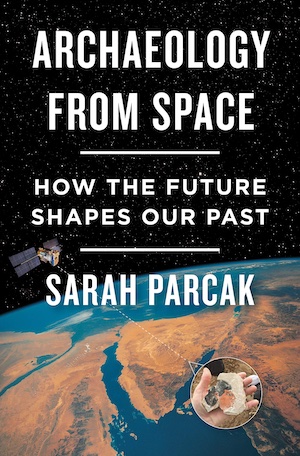Winner of the 2020 ΦBK Science Award
By Catherine A. Pilachowski
Sarah Parcak’s Archaeology from Space gives us a new perspective into the past, and not just the perspective from space. This intriguing book begins with the tools of archaeology and the insights to be gained from bones and artifacts. An aerial view adds more—clues to ancient geography and the ways our ancestors used and abused the landscape. To demonstrate the value of space archaeology, Parcak takes us to the site of Tell Tebilla along a long-vanished branch of the Nile through the ancient delta. Examination of space photographs from the 1960s revealed the buried walls of a temple enclosure, destroyed by the Persian invader Artaxerzes III, some 2400 years ago.
Space archaeology has come a long way since the early satellite imagery of the 1960s, with higher spatial resolution images and access to a broad range of wavelengths. Differences in crop growth or soil moisture reveal evidence of early human habitation underneath the surface, clues not easily seen through a pair of eyes on the ground. Examination of space imagery has already revealed thousands of previously unknown sites—with many more to be discovered. Globalxplorer.org, established by Sarah Parcak, gives every armchair archaeologist, young or old, the opportunity to locate and protect ancient ruins. Crowdsourcing engages these inquiring eyes to monitor known sites to spot looting or unauthorized construction that endangers those sites. Participating citizen scientists advance through more complex levels where they are able to search images to identify previously unknown sites. Nearly 100,000 participants from around the world have examined more than 100,000 square kilometers to identify new sites of interest. In Peru, for example, they found more than 700 features indicating large, new sites, and nearly 20,000 previously unrecorded sites of all sizes. Follow-up investigations suggest that 90% of these sites are archaeological in nature.
Parcak enlivens her narrative with both stories from her own excavations and scenarios that bring ancient people to life. From the goat who ate the essential site drawings (and ended up as the main course in the dig’s farewell celebration) to the 82-year-old ceramic specialist carried to a dig site on a palanquin, we share the hardships and joys of an archaeologist in the field. Throughout the book, Parcak takes her readers deep into the past to show us how archaeologists deduce the stories of ancient people from the shards and artifacts that remain, and introduces us to people who come to life through her words. Through her imagination, we can begin to connect more intimately with the lives of people who worked, built, loved, and died long ago.
A technological revolution has come to archaeology, and Parcak also shares her vision of where that revolution may lead. An archaeologist in the 22nd century may employ robotic tools and artificial intelligence to survey sites in hours that may take years or even decades to survey in our time. While her description of the exploration of a site in 2119 may seem fanciful, the seeds of that technology are already germinating today. Parcak also emphasizes that archaeologists are racing against time. Both looters and modern developments are encroaching on archaeological sites at a discouraging rate. To save our past, we must use all of the tools we have to accelerate the pace of exploration. And winning this race may yield the insights we’ll need to survive the future.
Archaeology from Space by the noted Egyptologist Sarah Parcak, a professor of anthropology at the University of Alabama at Birmingham, brings 21stcentury archaeology to life. Parcek is a pioneer in applying space imagery in archaeology, and a winner of the 2016 TED Prize, awarded to visionary leaders who are changing the world.
Catherine A. Pilachowski (ΦBK, Indiana University) is a Distinguished Professor and Daniel Kirkwood Chair in Astronomy at Indiana University Bloomington.




